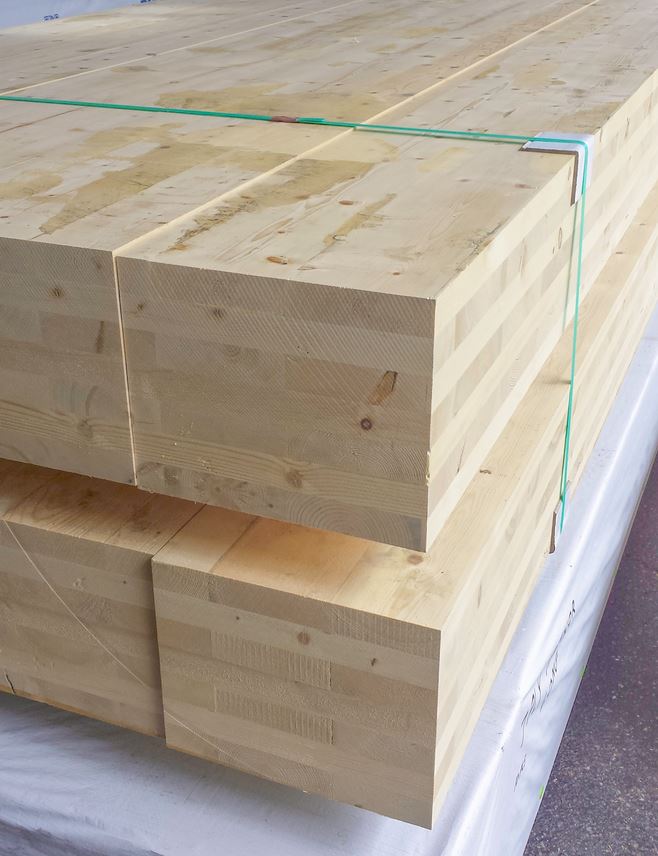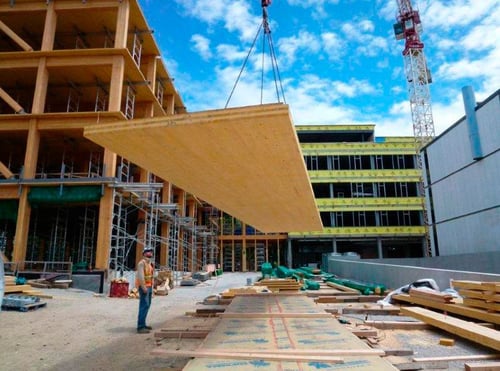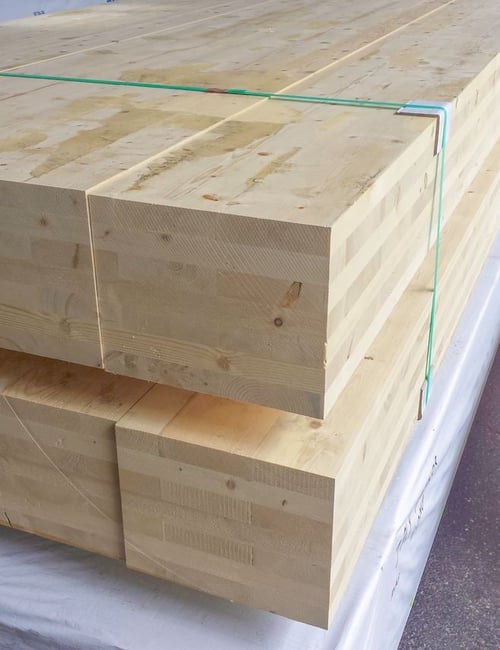
The cumulative impacts of the COVID-19 pandemic will continue to influence global wood markets for the foreseeable future. However, one forest products segment that is demonstrating sustained interest in the construction industry is the growing engineered wood/cross laminated timber (CLT) segment. Based on demand trends and increased popularity in green building products that stimulate the circular economy while sequestering carbon, CLT is only getting started.
Per the 2020 edition of Forest Products Annual Market Review, global production capacity of CLT in 2020 is estimated at 2.8 million cubic meters (m³), of which 48% is in Europe, 43% is in North America, 6% is in Oceania and 3% is in Asia. Austria, Czechia, Germany, Italy and Switzerland continue to form the epicenter of global CLT production; these five countries accounted for more than 80% of the estimated global production of 920,000 m³ in 2019. Two CLT plants are under construction in the Russian Federation, and another was recently completed in Ukraine that is now operational.
New developments in this sector have also been taking shape across North America. As of late 2018, ten mass timber panel manufacturing plants were in operation (five in both Canada and the US), with a combined annual production of about 400,000 m³. At the end of 2019, 14 plants were producing mass timber panels in North America, and three new facilities were under construction. While the current capacity of these plants is roughly 910,000 m³, industrial matting applications constitute more than half the total. The true capacity of mass timber panels for use in the construction sector across North America was about 439,000 m³ in 2019, and this is expected to increase by roughly 62,000 m³ for 2020.
What exactly is CLT?
Per the 2020 North American Mass Timber State of the Industry Report, which was compiled in part by our partners at The Beck Group, CLT is a panelized structural engineered wood product that can be used in all major building components (floors, interior and exterior walls, and roofs). As noted above, it is also used as a ground mat at construction and mining sites, allowing heavy equipment to operate on unstable soil.
CLT is made of three or more layers of lumber, each layer oriented perpendicular to the adjacent layer. The layers are then pressed together and bonded with a special adhesive. The lumber is typically pre-selected so major defects (knots, checks, etc.) are removed prior to lay-up. CLT panels used for building construction are commonly 8 feet - 12 feet in width, 20 feet - 60 feet in length, and in 3.5 inches - 9 inches in thickness. Panel length is limited only by press size and highway trucking regulations.
 Image courtesy of APA — The Engineered Wood Association
Image courtesy of APA — The Engineered Wood Association
Because the lumber is layered with alternating grain orientation, the strength, dimensional stability, and fire resistance of CLT panels are significantly greater than for individual boards. Many CLT panels are customized for a specific construction project, meaning the exact width, length, thickness (and arrangement of layers), and other properties of each panel are tailored to one building. Openings for doors and windows, as well as openings or channels for electrical, plumbing, and HVAC, are commonly pre-planned and cut by the manufacturer using CNC routers. The prefabricated panels therefore minimize the labor needed at the construction site and dramatically speed construction.
What are the raw material demands of CLT Production?
Manufacturing CLT requires raw materials and in this case, those materials are utilized in the form of finished lumber.
- Each square foot of building constructed with mass timber is estimated to consume 1 cubic foot of mass timber raw material.
- Each cubic foot of mass timber raw material is estimated to require 22.5 board feet of lumber to produce.
- Doubling the number of buildings made from mass timber every 2 years between 2020 and 2030 equates to an estimated increase in lumber demand of 3.25 billion board feet by 2030.
- 2019 North American softwood lumber demand (the primary raw material used for producing mass timber) was estimated to be 49.3 billion board feet. New softwood lumber demand arising directly from mass timber buildings in 2030 is estimated to be about a 6.5% increase over 2019 demand.
 Image courtesy of APA — The Engineered Wood Association
Image courtesy of APA — The Engineered Wood Association
What are the specifications required for lumber used to manufacture CLT?
The ANSI/APA PRG-320 – 2018 Standard for Performance-Rated Cross Laminated Timber (PRG 320) is a standard covering the manufacturing, qualification, and quality assurance requirements for CLT. It was developed by APA—the Engineered Wood Association—and the most recent edition was approved by the American National Standards Institute (ANSI) on February 6, 2018. Section 6, Subsection 6.1 of PRG-320 includes specifications for the lumber allowed for use in approved CLT panels.
- Species: Any softwood species may be utilized that has a specific gravity of at least 0.35 as published in the National Design Specification for Wood Construction. This specification level means that most commercially available softwood species used in structural applications can be used to manufacture CLT. Also specified is that each layer of lumber in a CLT panel must only use a single species. Adjacent layers of lumber within a CLT panel can be made from different species.
- Grade: In CLT panels, the lumber layers are referred to as either parallel (the major strength direction in a panel) or perpendicular (the minor strength direction in a panel). Lumber is graded in two ways:
- 1) Visually: where strength/grade is estimated from a visual inspection, or
- 2) Machine Stress Rated (MSR): where lumber pieces are measured for resistance to bending and assigned an according strength rating. Therefore, regarding lumber grade, parallel layers must be at least visual grade #2 or 1200f-1.2E for MSR. Perpendicular layers must be at least visual grade #3 or equivalent.
- Thickness: The minimum thickness of any lumber layer is 5/8 inch at the time of gluing. Maximum thickness is 2 inches. Thickness must be consistent across each individual layer. Thickness consistency is defined at the time of bonding as plus or minus 0.008 inch across the width of the layer, and plus or minus 0.012 inch across the length of the layer.
- Width: In the parallel layers, the width of a piece of lumber must be at least 1.75 times its thickness. In the perpendicular layers, the width must be at least 3.5 times its thickness.
- Moisture Content: For lumber used in CLT panels, the moisture must be 12%, plus or minus 3%, when the panel is manufactured. For structural composite lumber used in CLT panels, the moisture must be 8%, plus or minus 3%, at the time of manufacture.
- Surfacing: Any lumber used must be planed, at least on any surfaces to be bonded, and the planed surface must not have any imperfections that might adversely affect the bonding process (i.e., raised grain, skip, burns, glazing, dust).
For a deeper dive on everything related to CLT, we highly recommend checking out the 2020 North American Mass Timber State of the Industry Report. In a follow-up post on this topic, we will explore regional timber resources and lumber availability for CLT production moving forward.
Learn more about the new innovations and opportunities surrounding mass timber products at the virtual International Mass Timber Conference, which will be held March 30 – April 1.





